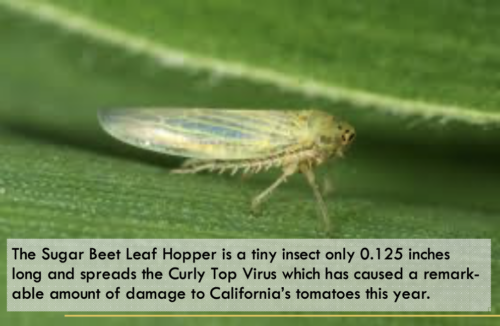 California growers have contracted for a near-record crop of 13.1 million tons of processing tomatoes in 2013, according to the California Processing Tomato Report. Contracts are 4.5% more than last year’s crop and just shy of the record 13.3 million ton crop set in 2009.
California growers have contracted for a near-record crop of 13.1 million tons of processing tomatoes in 2013, according to the California Processing Tomato Report. Contracts are 4.5% more than last year’s crop and just shy of the record 13.3 million ton crop set in 2009.
While fields in the northern regions of California are thriving, the ones in the south are struggling with hot weather and disease. Since two‐thirds of California’s tomatoes are grown in the south, sources close to the field predict the crop will fall below contracted volume.
When growers transplant in the spring, they typically worry that winter might reappear and damage the crop with frost and rain.
But this year, there was not enough winter. Coming fresh from the controlled, temperate greenhouses, seedlings were shocked by summer‐like temperatures and fierce winds that stunted plant growth.
Drought stretches over the state. After a wet early‐winter, rain all but disappeared in January and February. To conserve the limited resource, state and federal water projects granted only 35% and 20% of normal allocations for farms south of the delta.
Generally, tomatoes do well in drought years because growers provide just the right amount of water at the right time with irrigation. But the wind and heat diminished benefits normally realized by precision watering.
To compound the issues in the south, crops were struck hard by the Curly Top Virus. In areas where the disease was acute, acreage was either aban‐ doned or replanted. It’s estimated that 10% of the southern acreage was affected, but it is anyone’s guess as to how that will shape final the outcome of the 2013 crop.
The Curly Top Virus is spread by a small insect known as the Sugar Beet Leaf Hopper. It’s well known that when the rains stop and the foothills dry out, the Leaf Hopper migrates down to irrigated fields in search of food. In order to protect California’s crops, each year a state-administered program sprays hill regions, road sides and fallow fields to control the pests.
This year’s outbreak was unusually voracious for several reasons. High winds kept the state from implementing its spraying program in a timely fashion. And the Leaf Hopper itself prospered in the abnormally warm, dry conditions. Not only was the population larger than normal, but Leaf Hoppers migrated multiple times, instead of just once, and a higher than normal percentage were carriers of the virus.

Morning Star Newsletter now distributed electronically
As a reminder, Morning Star is now distributing our newsletters electronically using an email distribution vendor called Mailchimp. Your e-version will now include informative Morning Star videos and highlights. Depending on your company's firewall, these emails may initially be directed to you spam folder.

